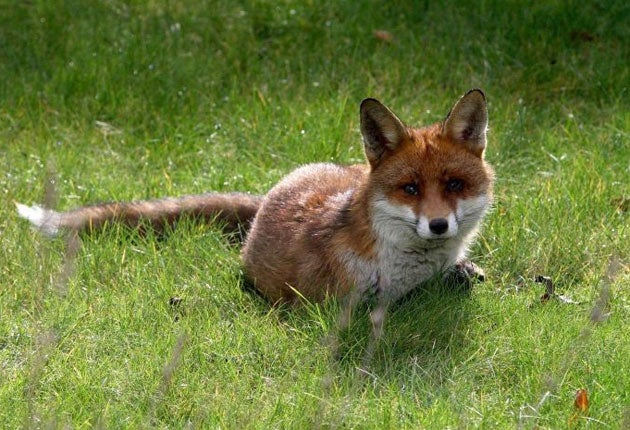We shouldn't cry wolf about foxes
The scourge of the countryside has invaded our towns and cities. Must urbanites live in fear? Holly Williams sniffs out the truth about a misunderstood creature

Your support helps us to tell the story
From reproductive rights to climate change to Big Tech, The Independent is on the ground when the story is developing. Whether it's investigating the financials of Elon Musk's pro-Trump PAC or producing our latest documentary, 'The A Word', which shines a light on the American women fighting for reproductive rights, we know how important it is to parse out the facts from the messaging.
At such a critical moment in US history, we need reporters on the ground. Your donation allows us to keep sending journalists to speak to both sides of the story.
The Independent is trusted by Americans across the entire political spectrum. And unlike many other quality news outlets, we choose not to lock Americans out of our reporting and analysis with paywalls. We believe quality journalism should be available to everyone, paid for by those who can afford it.
Your support makes all the difference.There are an estimated 33,000 urban foxes in cities in Britain, with many more – some 225,000 – living in rural areas, according to the University of Bristol's Mammal Research Unit.
Foxes have been fond of living in our cities since the spread of the suburbs in the 1930s. The expansion of low-density housing, often with substantial gardens attached, attracted foxes to move in with us.
In an urban environment, the fox faces no natural predators. Although foxes can live up to 15 years in captivity, in the wild a mere 16 per cent make it past their second birthday. The London Wildlife Trust estimates that 60 per cent of the capital's foxes die every year. About half of these will be killed in road collisions.
In cities where sarcoptic mange, caused by a parasitic mite, is widespread, it may cause even more deaths among foxes than do cars. The chance of a pet dog catching it from a fox is slim, and there have only been 11 known cases of a cat catching mange worldwide since 1973.
The number of foxes living in British cities had been pretty stable since the middle of the last century, but during the Nineties the spread of mange caused a serious decline. In some urban areas, 95 per cent of foxes were killed by the disease.
British foxes are smaller than we might think – only a little larger than a domestic cat. The male will weigh between four and eight kilos; the vixen between four and six. A third of their body length belongs to that distinctive bushy tail.
Foxes are faithful sorts. The dominant male and the vixen form a pair that can last a lifetime. While they are solitary travellers, hunters and feeders, the pair will continue to meet in order to mate, play and groom each other.
Urban foxes may also have an unconventional family set-up: it's common for an adult fox to remain with the breeding pair. This 'helper' is often the grown-up offspring of their previous litter who failed to leave at the usual age and is subordinate to the mating pair.
The average litter is of four or five cubs, born blind, deaf and with black fur. They weigh about 100g and are 10cm long. The female remains in the den at the beginning, while the male brings food. The cubs do not leave the warmth of the den for the first few weeks.
At about 12 weeks, cubs start to forage for their own food, and many die at this age. If they make it, at 16 -18 weeks they can find their own meals without the help of the adults.
From the 1940s to 1970s, the Ministry for Agriculture, Fisheries and Food and the London boroughs attempted to control fox numbers through culls. But when a fox dies its territory comes up for grabs; within days a dead fox may have been replaced by a new one. Lethal control is also expensive, so not usually seen as an effective approach.
In the 1800s, however, the fox population was successfully reduced around East Anglia and east Scotland through poisoning and leg-hold traps – practices which are now illegal.
Contrary to popular opinion, foxes are not big scavengers. One survey of 5,480 urban households found that more than 80 per cent believed they had never had their dustbins rifled by foxes; 16.4 per cent of households said they had occasionally, and 2.7 per cent frequently.
City foxes are still well-fed, however. A study in Bristol found that within each fox's territory there was around 150 times as much food available as they needed.
Pet owners are often nervous of foxes, but the incidence of foxes hurting domestic animals is low. In an area of north-west Bristol, where there was known to be an unusually high density of about one fox per 100 cats, researchers discovered that 0.7 per cent of the pet cats were killed by foxes in a year. That's eight out of the 1,225 cats in the area.
Urban foxes are rather popular with the British public. A survey of 4,000 households across Britain found that more than 65 per cent liked urban foxes; just over 25 per cent had no strong view; and only around 8 per cent disliked them.
Attacks on children by foxes are rare in the extreme. The risk from domestic dogs is far higher – there are over 5,000 serious injuries caused to humans by dogs each year in Britain.
Join our commenting forum
Join thought-provoking conversations, follow other Independent readers and see their replies
Comments